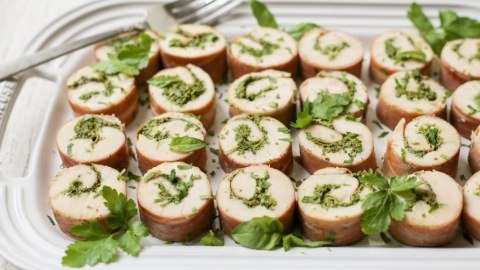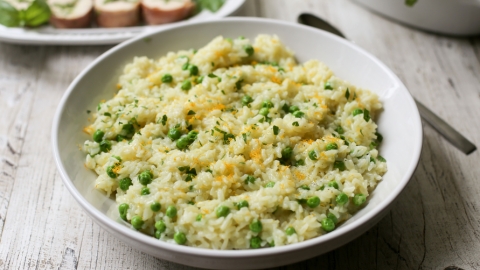Third-Generation Kitchen Technologies
Sous Vide Cooking
The Next Generation
Sous vide cooking used to be relegated solely to commercial kitchens, but the latest wave of appliances are perfect for the home kitchen. Called immersion circulators, these gadgets can be placed inside any stockpot or food-safe container to heat water to a precise, consistent temperature. This allows you to cook any food to an exacting degree, without fear of over- or undercooking.
My immersion circulator of choice is the Anova Wifi Precision Cooker. It pairs with an iOS/Android app, so you can set and monitor the temperature and cooking time remotely. The app also includes an index of chef-tested recipes, ensuring great results.
Do I Need A Vacuum Sealer?
If you’re serious about sous vide, you may want to get a vacuum sealer as well. Most sous vide cooking is done in food-safe plastic bags, and they must be sealed without any air in order to submerge properly in the water bath. The easiest way to accomplish this seal is with a vacuum sealer. The model from Oliso is simple to use and works with either dry or wet ingredients.
If you want to forego the vacuum sealer, you can use resealable freezer bags instead. In his Sous Vide 101 Guide on SeriousEats.com, J. Kenji Lopez-Alt explains the water displacement method very well:
“The best way to remove air from a zipper-lock bag is to place the food inside it, close all but the last inch of the bag’s seal, then gently lower the bag into a water bath. The water will push the air out of the bag as you lower it. Seal the bag just before water starts to get inside and you’ll end up with a completely air-free seal.”
Perfect Proteins and Vibrant Vegetables
Before I started cooking sous vide, I wasn’t a big fan of boneless, skinless chicken breasts. I’ve since changed my tune. Chicken breasts cooked to a precise 149ºF are perfectly silky in texture, and the sous vide method allows for safely cooked proteins at lower temperatures since they have time to pasteurize without overcooking. In the recipe here, chicken breasts are butterflied, wrapped in prosciutto, and spread with pesto. These roulades make for a pretty presentation, and all of the flavors are spiraled throughout.
Vegetables retain incredible flavor when they are cooked sous vide, far more so than if they were steamed or boiled. If you enjoy springtime favorites like steamed carrots and asparagus, try them cooked sous vide, sealed with a knob of butter and a pinch of salt. Turnips, fennel and other hardy vegetables also take beautifully to this simple method.
Another great vegetable to cook sous vide is garlic. When cooked in butter, the cloves become soft and tender, infusing the butter with their mellowed flavor. I’ve added anchovies to the mix to create a no-fuss, hands-free bagna cauda sauce. There’s no need to watch it simmering on the stove. Simply drop the bag into your sous vide water bath, step away for three hours, and the sauce simmers itself. Blended with olive oil, it makes a pungent, delicious dip for fresh spring radishes.
Electric Pressure Cookers
Programmable Pressure Cooking
Pressure cooking has come a long way since its beginnings on the stovetop. Electric pressure cookers are now in their third generation of technological development. They’re as intuitive to use as microwaves, with presets and programs that make cooking dinner as easy as hitting a few buttons. Even the most basic models on the market are capable of sautéing, slow cooking, pressure cooking and keeping your food warm for hours after it is ready. I like to think of mine as a slow cooker on steroids.
Which one should I buy?
The most technologically advanced pressure cookers currently available are manufactured by Breville, Fagor and Instant Pot. The one I use for all of my recipes is the Instant Pot IP-DUO60. Its intuitive presets allow for even more convenience than more basic models. There are specific programs for cooking stews, different kinds of meat, rice and other grains—it even heats and cultures yogurt from scratch. The six-quart capacity is generous enough to make recipes that serve four to six people, but it handles smaller quantities just as well.
Speed Under Pressure
The biggest advantage of pressure cooking is speed. Most foods will cook in half the time or less when compared to traditional methods. Once the appliance comes up to pressure (this takes five minutes or more, depending on the temperature and volume of ingredients you’re using), a timer will count down and let you know when your food is ready. At this point, you can either wait for the pressure to release naturally or release the pressure valve manually. I like to place a damp towel over the valve when I use this “quick release” method, since it helps to capture and diffuse the steam.
Risotto is one of my favorite foods to make in my pressure cooker. It’s a quick, easy side dish that I can pull together on a weeknight or serve for a special occasion. It starts just like a traditional version, with diced shallots sautéed in butter and olive oil. The recipe speeds up when the broth is poured in all at once, rather than ladled in stages. The rice cooks in seven minutes instead of the usual 20, and it comes out just as creamy and delicious as if you’d stirred it all the while.
Coco Morante is a Silicon Valley–based food writer, classical singer and author of the blog It Was Just Right (ItWasJustRight.com). Contact her at coco@itwasjustright.com.





